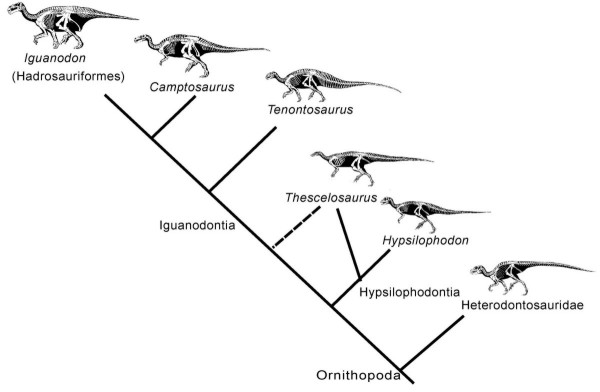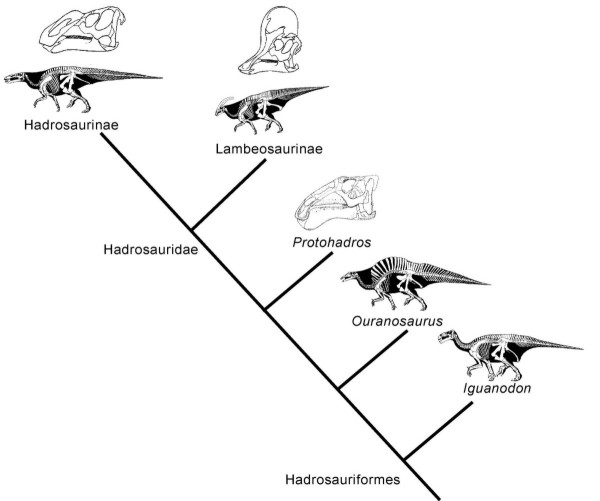
Ornithopods and marginocephalians are sister taxa within Ornithischia: both have gap between premaxillary and maxillary teeth and enlarged predentaries, among other features. This distinguishes them from primitive ornithischians (e.g., Pisanosaurus, Lesothosaurus) and thyreophorans.
Most primitive of ornithopods include Heterodontosauridae:
- Best known represntative is Early Jurassic Heterodontosaurus of southern Africa
- Found from possible Late Triassic teeth, and up through Late Jurassic; most common in Early Jurassic
- Retained large grasping hands (lost in most other ornithischians)
- Very stout jaws; lower jaws may have scraped inward to help chew food
- Back teeth were chisel-like to shear through tough food
- Some taxa (maybe only males?) had large canine-like fangs
- Some paleontologists think that these may be closer to marginocephalians than to true ornithopods
More advanced ornithopods share certain synapomorphies:
- Reduced antorbital and mandibular fenestrae
- Prepubic process on pubis (extends forward): also seen in ceratopsoids)
Hypsilophodonts
- Mostly small (1-3 m long), obligate bipeds
- Probably fast runners
- Jaws show beginning of a hinge joint in maxilla (better developed in iguanodonts)
- Earliest forms in Middle Jurassic, persist until end of Cretaceous
- Most famous representative is Hypsilophodon of the Early Cretaceous of Europe and North America
- Very likely paraphyletic: some forms were probably more closely related to Iguanodontia than to other hypsilophodonts
Iguanodonts
- Almost all are larger than hypsilophodonts or heterodontosaurids
- Most have stout forelimbs, and were probably facultative bipeds
- Used hindlimbs only when running and feeding on trees
- Used all four while walking and when browsing on low vegetation
- Characterized by loss of premaxillary teeth
- Earliest are in Middle Jurassic, but become more common in Late Jurassic and Early Cretaceous
- Among the most famous are Camptosaurus of the Late Jurassic of western North America (and possibly Europe) and Tenontosaurus of the Early Cretaceous of western North America
The larger and more specialized iguanodonts form a clade, Hadrosauriformes:

Hadrosauriforms:
- Generally quite large, 7-14 m long
- Spent a lot of time on all fours
- Nares were large
- Manus was highly specialized:
- Digit I formed a conical spike
- Digit V was long and opposable
- Metacarpals II-IV were long
- Digits II-IV were hoof-like
- Jaws and teeth were also highly specialized
- Special hinge-like joint between maxilla and rest of face allowed upper jaw to swing outward when lower jaws closed, chewing food (rare in reptiles)
- Teeth are found only in back half of jaws
- Early Cretaceous hadrosauriforms include Iguanodon of Europe, North America, and possibly Asia; Ouranosaurus of northern Africa (with extremely tall neural spines: possibly for display and/or thermoregulation); and Protohadros of North America (probable ancestor of Hadrosauridae, the most specialized of all ornithopods
- EXTREMELY common in Late Cretaceous of North America, somewhat less common but present in Asia, Europe, South America
- One of the most common plant eaters in Late K: known from eggs through adults
- At least some species lived in herds and had nesting colonies
- Many distinguishing features, including:
- End of snout flares outward to form "duck bill"
- Huge increase in number of teeth
- Teeth organized into dental battery: a continuous grinding surface
- Allowed the most complex and sophisticated chewing of any reptile
- Comparable to the chewing ability in modern herd mammals
- Manual digit I lost
- Metacarpals II-IV very long and slender: probably spent most of the time on all fours
- Hadrosaurinae, characterized by enlarged external nares and broader snouts
- Lambeosaurinae, characterized by hollow crests on top of head
- These crests house the nasal passage
- Debate on possible uses of lambeosaurine crests:
- Increase surface area for smelling sensors
- Sound generation (equivalent to woodwind or brass instrument)
- Visual display
- Trapping moisture in exhaling breath to keep lungs from drying out
- Or a combination
- Lambeosaurine crests vary from species to species, and from sex to sex
- Babies, males, and females of a species were often once classified as different species
- Most baby lambeosaurines look alike: their distinctive crests only show up when they were almost full grown
To Next Lecture.
To Previous Lecture.
To Syllabus.